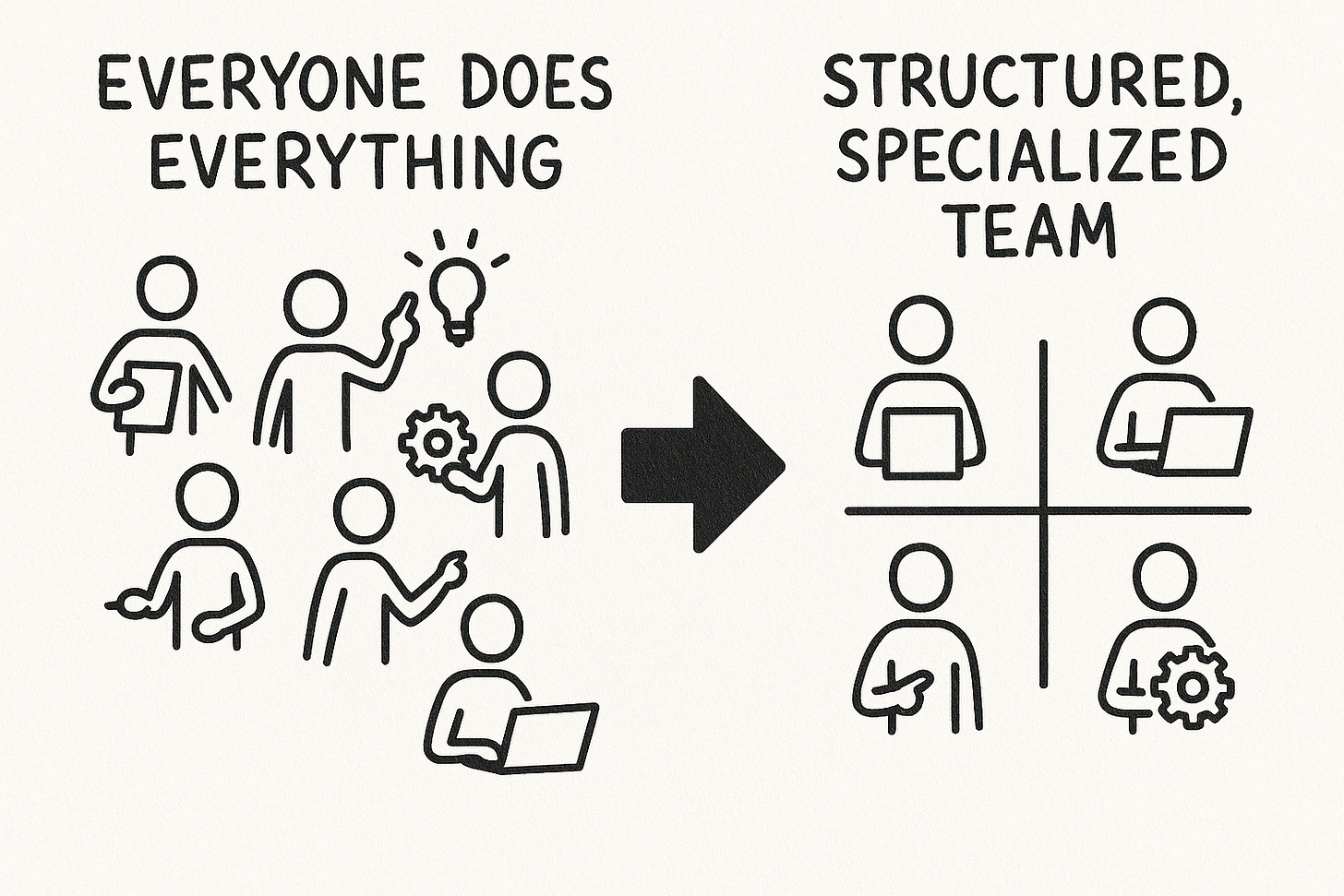Structuring your RevOps team to avoid single points of failure
More and more I have been seeing how small RevOps teams who have the “I can do it all” mindset succumb to burnout and attrition. While the “can do” attitude is admirable, your team and its efforts cannot scale if everyone is doing everything. Duplication of efforts and tag teaming on everything results in critical tasks falling through the cracks.
Especially today, when RevOps teams are crunched for resources and driving large revenue growth targets with sales, having a clear org chart is critical to project confidence to the broader GTM organization and avoid those devastating single points of failure.
The hidden cost of being a RevOps generalist
Most RevOps team members are jacks of all trades. Job descriptions from analyst to director levels require an ambitious mix of analytics, Salesforce expertise, compensation planning and sales strategy experience.
And that works great in the early stages of GTM evolution, when a small and mighty RevOps team gets to be the hero - the same rockstar who designed the first ever custom compensation plan cranks out the first sales performance dashboard and helps the VP of Enterprise Sales with their forecast.
However, that results in the creation of a single point of failure, and when that rockstar inevitably burns out and gives notice, the rest of the team is scrambling to pick up the pieces. As complexity in the GTM organization increases, specialization and consistency within the RevOps team become more important.
So when should you establish structure to your RevOps team?
“Most of us are good enough in Salesforce to be dangerous,” someone who worked in RevOps at a rapidly growing SaaS company told me recently.
Whoa, that does sound dangerous! Salesforce would turn into a minefield if all your RevOps analysts moonlighted as Salesforce admins!
And sure enough, as Salesforce fields proliferated, the rapidly growing SaaS startup set up a centralized Business Systems team, and cracked down on some of the more creative Salesforce permissions that the broader RevOps team had. Phew!
You need to define a clear org structure for your RevOps team much before you get to breaking point. Some indicators are:
When 20+ GTM team members are on sales incentive plans, you certainly need a dedicated Compensation planning/ execution role
When your sales teams on incentive plans are clamoring for weekly attainment reporting and your Salesforce report has 10+ filters that break every day, invest in a Centralized revenue analytics function
When you have at least two distinct sales segments with differing sales motions, led by different sales leaders, dedicate a Field ops role to support each sales leader
When you hear rumblings from the field that they have reached out to multiple RevOps team members but still have not been able to get basic questions answered on reporting accuracy or incentive plan mechanics, clarify your go-to points of contact!
When one person has repeatedly been identified as a single point of failure, someone who owns everything from compensation planning, to performance reporting to business partnering, bring your team together to discuss a sustainable split of roles and responsibilities
==> Even if you just have a small RevOps team supporting a small but rapidly growing GTM team, it is worth aligning RevOps analysts to pillars to drive accountability and avoid those single points of failure.
What should your RevOps team look like?
Your team can take several forms, but very few teams can avoid a Central RevOps function with the following pillars:
Sales systems & tooling (some companies may house their business systems teams in IT, while maintaining a liaison business systems analyst in RevOps, that’s a whole other blog post!)
Sales training & enablement
Sales strategy & planning
Compensation, quotas & territories
Revenue analytics
These pillars establish best practices, driving standardization and efficiency, owning critical central processes like:
Tech stack management and review
New hire onboarding, sales coaching and productivity enhancements
Annual planning
Incentive design
Conducting monthly/ quarterly business reviews etc.
Depending on the size and complexity of your GTM organization some of these pillars can be combined. For instance, the same sales strategy & planning analyst who leads annual planning can pivot to GTM readiness, setting quotas and building territories, once the annual planning cycle is complete.
For larger, more complex organizations where annual planning is a large, cross-functional effort, you may need multiple analysts covering strategy & planning, compensation and quotas, and a senior manager/ director leading the team.
Rarely can these pillars be successful without a strong Field RevOps team, business partnering with GTM leadership to implement GTM strategy, and providing the “voice of the field” to your central teams.
The tussle between Central RevOps and Field RevOps. Who does what?
A close partnership is crucial between your Central and Field RevOps teams, but often the line is blurry between the two.
The Field RevOps team serves as the COO to your segment/ regional sales leadership:
They own regional operating cadences like:
Weekly forecasting
Driving pipeline rigor
Territory building, leveraging central data sources
Piloting new sales motions and programs
Some custom reporting to support in-region SPIFs etc.
They provide input into global cadences run by the Central RevOps team, and then cascade the roll-out into the field, serving as the first line of defense for questions before escalating to the Central team
It is always beneficial to have standardization in GTM roles, core performance metrics and incentive design even across different geographies and segments. However, if your sales teams operate differently in different geographies because of market differences, your FieldOps team might lean in even more into central cadences to recommend customizations and add regional nuance.
I would love to hear about how your experience setting up and scaling a successful RevOps organization. What structures have worked well for you? What warning signs have you seen indicating that something isn’t working? Whether your organization is large or small, I would love to chat!


